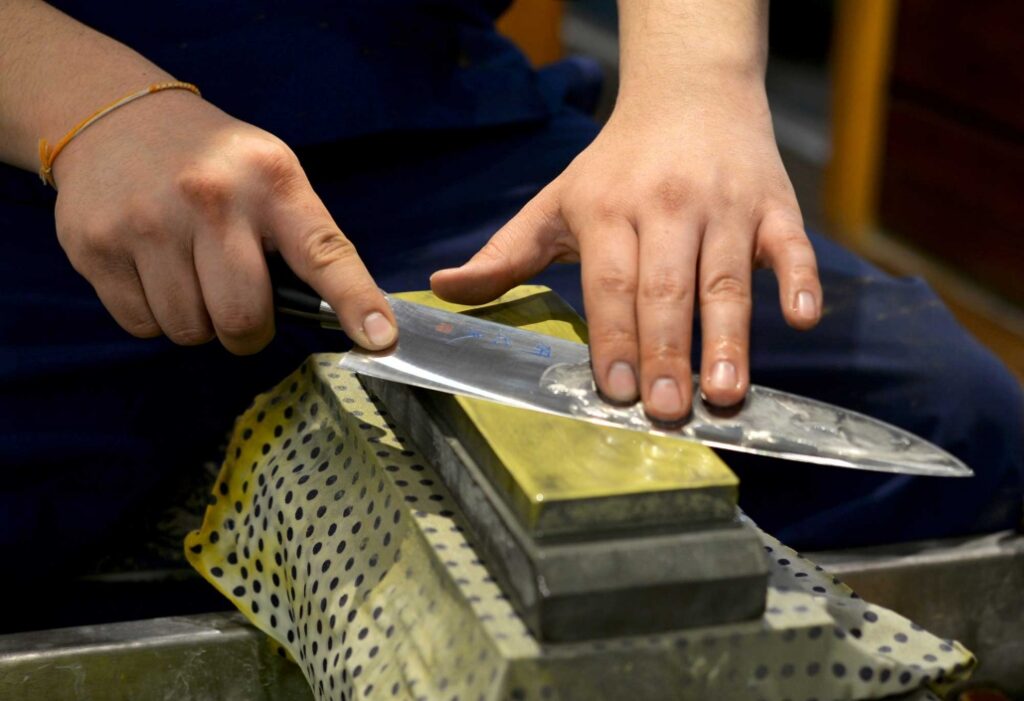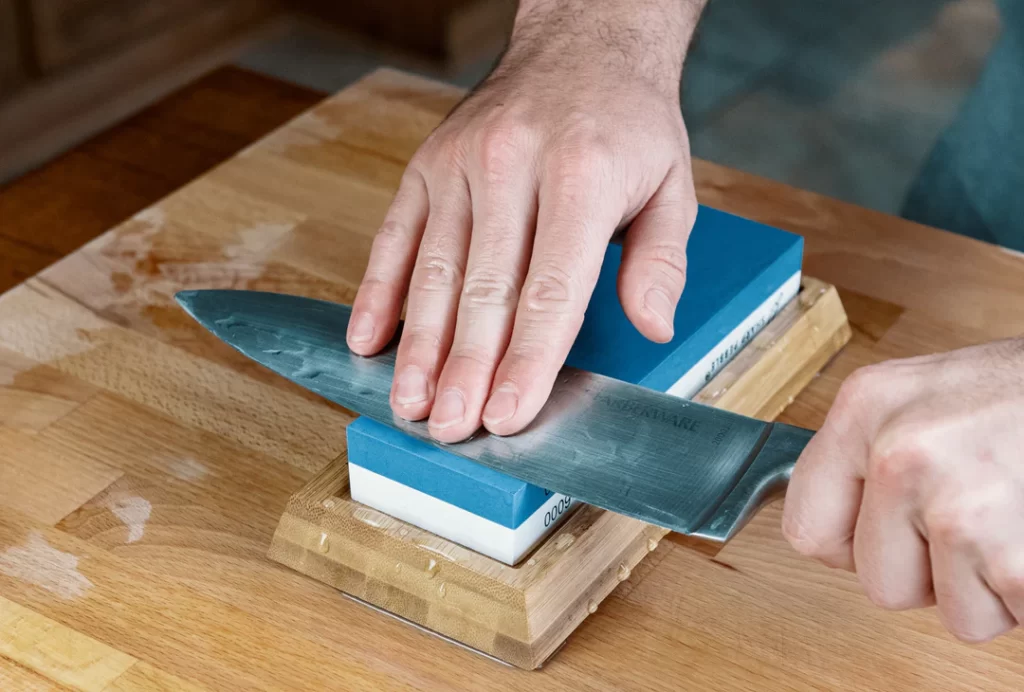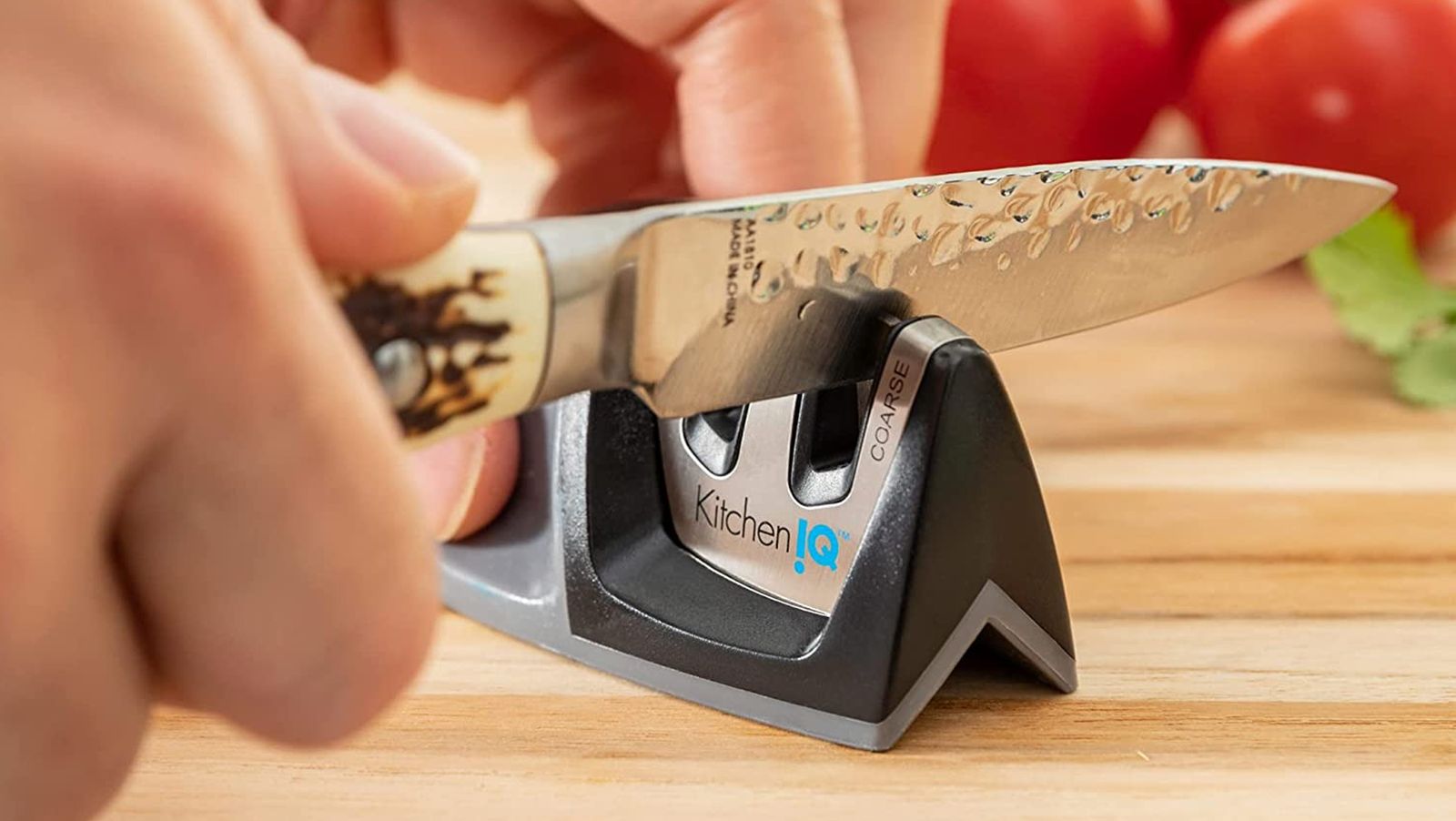Last updated on January 7th, 2024 at 12:36 pm
Knife honing: our whole guide! Here’s how to sharpen blades for precision cutting. This article’ll discuss knife honing’s importance, methods, and blade maintenance.
Understanding knife honing is vital for maximum cutting performance, whether you’re a chef or a home cook. Let’s learn about this vital talent!
What is Knife Honing?
Honing restores a knife’s edge. A honing rod or steel removes any misalignments or small burrs from regular use. Honing straightens the knife’s edge, not sharpens it. This method preserves the knife’s cutting ability and longevity.
The Importance of Regular Honing
Knife honing is essential. First, it maintains the blade’s edge, making precise cuts easy. Honing decreases the danger of the blade slipping or sticking when cutting, preventing mishaps.
Regular honing keeps the blade sharp and increases the period between sharpenings, keeping its shape and reducing material removal.
Different Types of Knife Honing
Knife honing uses rods or steels. Honing rods, often called sharpening sticks, are cylindrical rods composed of ceramic, diamond, or steel. Professional and residential cooks use them to align blade edges.
Honing steels are long, thin steel rods. They remove microbursts and straighten blade edges. Honing steels come in various sizes, shapes, and grits to sharpen different blades.
What is the Anatomy of a Knife

Knife blades cut. Point, edge, spine, and tip. The spine supports the edge, which cuts food.
Tang: The blade’s handle-extending tang. It stabilizes the knife.
Handle: You hold the knife’s handle. It should be easy to hold and made of wood, plastic, or metal.
Bolster: The broad blade-to-handle connection is the bolster. It balances the knife.
Rivets: Rivets hold the handle to the tang. They help the knife last.
Tools and Equipment for Honing

Tools are needed to sharpen blades. Essentials include:
Honing Rod: A long, cylindrical honing rod, sometimes called a sharpening rod or honing steel, straightens and realigns the blade’s edge. Ceramic, diamond, and steel are available. Choose an honing rod for your needs and knives.
Honing Steel: Steel honing rods. It removes microbursts and aligns the blade. Choose an honing steel that matches your knives.
Sharpening Stones: Useful for blade maintenance, but not for honing. They’re available in different grits to sharpen and polish knives.
Cutting Board: A good cutting board is solid for knife sharpening. Wood or plastic boards won’t damage the blade.
Cleaning Cloth: After honing, wipe the knife clean with a cleaning cloth.
Step-by-Step Guide to Knife Honing

Alternate strokes on both blade surfaces. For even honing, aim for a consistent amount of strokes per side.
Hone while listening and feeling the blade. A well-aligned blade hones smoothly and resists resistance.
Clean the blade after honing. Paper-test the knife’s sharpness. Gently slice a piece of paper. Honed knives cut nicely.
Depending on knife use and blade condition, repeat honing. Sharpening regularly is advised.
Honing Techniques for Different Blade Types

For maximum results, different knives need different honing methods. Some blade-honing methods:
Straight-Edged Knives: Use a smooth honing rod or steel for chef’s and utility knives. Maintaining a 15–20-degree angle, gently brush the knife along the rod.
Serrated Knives: Serrated knives’ toothed edges make honing harder. Keep serrated knives sharp without an honing rod. Use a serrated blade-specific ceramic sharpening rod. Align the rod with the serrations and slowly glide it along the edge, following the tooth angle.
Japanese-Style Knives: Honing thin, delicate Japanese-style knives require special care. Avoid material loss by using a fine-grit honing rod or steel. To retain sharpness without damaging the blade, hold the knife at 10–15 degrees and use light, steady strokes.
Common Mistakes to Avoid in Knife Honing

Honing is simple, but individuals make mistakes. Avoid these errors:
Too Much Pressure: Over-honing can ruin the blade or create an uneven edge. Use light, controlled strokes.
Incorrect Angle: Honing requires the right angle. The blade may misalign if the angle is excessively steep or irregular, reducing sharpness. Maintain a knife-specific angle.
Over-Honing: Too much honing removes material from the blade, limiting its lifespan. Use a knife-use-based honing regimen and only hone when needed.
Using the Wrong Honing Tool: Some knives require specific honing equipment. Avoid damage and ineffective honing by using the right honing rod or steel for your blade type.
Tips for Maintaining Sharpness

knife sharpness:
Use a Cutting Board: Use a wood or plastic cutting board to avoid dulling the blade. Cutting on stone or glass dulls the knife.
Hand Wash Knives: Dishwashers have dull blades and destroyed handles. Hand wash and dry your knives with mild dish soap and warm water before storage.
Store Knives Properly: Knife blocks, magnetic strips, and sheaths protect blades and prevent accidents. Knives damaged and dulled by loose drawer storage.
Avoid Cutting Frozen Foods or Hard Surfaces: Avoid Cutting Frozen Meals or Hard Surfaces: It’s tempting to use your knife to chop frozen meals or hard surfaces like bones or ice, but don’t. These materials can prematurely chip or dull the blade.
Hone Regularly: Hone your knives regularly. Hone knives every 2-3 weeks, depending on use.
Sharpen When Necessary: Honing maintains blade alignment, but sharpening is still needed. When honing doesn’t work, sharpen the blade. Sharpening stones or systems can be used to sharpen knives at home or professionally.
How Often Should You Hone Your Knives?
Honing your knives depends on how often you use them and the type of knife. Hone knives every 2-3 weeks. If you use your knives often or notice a drop in cutting performance, you may need to hone them more often.
Honing maintains blade edge alignment and extends sharpening intervals. Honing keeps blades sharp and extends their lives.
Questions (FAQs)
When should I sharpen my knife?
Your knife may require sharpening. These include poor cutting ability, the blade slipping or catching, or a misaligned edge. Hone your knife if it’s not performing well.
Honing harms the blade?
Honing properly should not damage the blade. However, inappropriate pressure or technique causes damage. To avoid blade damage, precise honing processes, tools, and angles must be followed.
Honing: how long?
Honing takes only minutes. The time necessary depends on the amount of knives you are honing and your experience. Practice makes knife sharpening easier.
Honing rods or steels for all knives?
Chef’s, utility, and other straight-edged knives can be sharpened with honing rods or steels. However, ceramic knives may not be suited. For precise knife-honing instructions, consult the manufacturer.
Can an honing rod or steel sharpen a dull knife?
No, honing rods and steels are for maintenance and edge alignment, not sharpening dull blades. You’ll need a sharpening stone or a professional to sharpen a dull knife.
Should the honing rod or steel be long?
The honing rod or steel should be longer than the blade being honed. This makes honing easier, especially for larger blades.
Conclusion
Sharp, precise cutting instruments require knife honing. Honing knives periodically keeps them sharp, extends their lifespan, and ensure safe and efficient kitchen chopping. Avoid frequent blunders by using the right honing tools and techniques.
With experience and attention to precision, you’ll master knife honing and enjoy sharp, reliable blades in your cooking.
